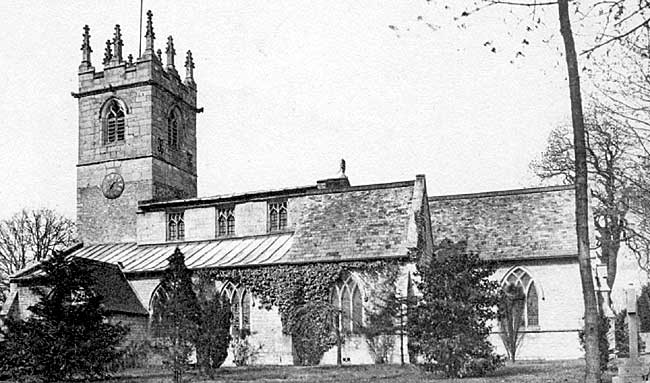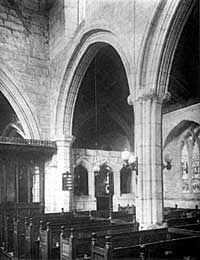Clayworth
BY THE REV. A.W.B. MARSHALL

Clayworth church.
The village and parish of Clayworth, which appears in Thoroton as Clavood, or Claworth, and is mentioned in Domesday Book as Clavord, with its sister parish of Wiseton, or Wiston, stands on slightly rising ground, within a short distance of the river Idle, which flows by the ruins of what was once the rich and important priory of Mattersey, the prior of Mattersey holding "a Grange & good Lands" in Clayworth.
A Roman way, apparently from Doncaster to Littleborough on the Trent, through Bawtry, Scaftworth, and Everton, and by what is now known as Drakeholes and Wiseton, evidently passed through Clayworth, and it is believed that the present church of St. Peter stands close to the line of the old Roman road-this "way" seeming to continue its course through Wheatley and Sturton, down to the banks of the Trent.
Clayworth, then, is interesting to the archaeologist and antiquary from every point of view, but it is chiefly as regards the history of the church, perhaps, that the members of the Thoroton Society today would wish for a few facts.
I make no pretensions to being an archaeologist myself, but am, and always have been, intensely interested in all that I can learn about church architecture, and of course specially in what tends to throw light on this beautiful church of St. Peter, in which we take such pride. As you drove today down from Drakeholes you, I have no doubt, traversed that road on which, long ago, Roman horses and carriages, or chariots, wended their way from Doncaster to Lincoln, and you would see in the distance the embattled square tower of St. Peter's church of Clayworth.

Interior of Clayworth church.
I was told by an archaeologist, who visited this church some two years ago, that certain portions of it, the lower part of the tower and part of the present chancel arch wall, belong to the Saxon period. Without accepting that opinion, I would point to the solid and massive construction of the tower, to a very small window above the west window therein, and on the north side of the wall of the chancel arch, to some portions of masonry of a quasi-herring-bone style, as certainly speaking of great antiquity. Norman work is apparent in the north and south doors, and it would appear to be almost certain that the original chancel arch was Norman, as witness what remains of the capital of a Norman pillar on the south side of the present chancel screen, and a small piece of carved work immediately below. Probably the arches and corresponding pillars of the nave were originally Norman work, and this seems borne out by the bases on which the present pillars stand, they however were evidently replaced by early English work. There are various carved heads appearing on the second pillar of the first bay on the north side, which are undoubtedly very old, but seem to have been inserted in their present place from somewhere else, and there are two sorts of small shafts, one on the north side and one on the south, which call for remark, and suggestions as to what they originally were or formed part of.
On looking eastwards, on the chancel wall will be seen traces of two different pitches of roof, other than the present one, and appearances which seem to point to the former existence of a Norman or circular-headed window above. The few steps leading up to the rood-loft still remain at the back of the present pulpit. The line of the addition of the clerestory is very plainly marked, and the three two-light windows on each side are good examples of late Perpendicular work. The beautiful little side chapel, dedicated to St. Nicholas, restored and panelled round at the cost of Lady d'Arcy Osborne, a generous benefactor, and further beautified with two good windows by Kempe, the gift of Mr. R. C. Otter's family, is a very pleasing and much admired feature of the church.
The chancel itself is spacious and of good proportions.

Brass in Clayworth church.
Note the arch which leads into St. Nicholas' chapel, and the two on the opposite side of the early English work, the more easterly one, however, being probably nearly 200 years later. There is a fine example of a plaster tomb on the north side of the chancel, on which is a brass recording the burial at Clayworth, in 1556, of Humphrey FitzWilliam, who married Anne, daughter of William Dalison (Dalyson), of Laughton, in Lincolnshire, who was also buried here in 1558, having had a goodly family of six sons and four daughters. The arms of Fitzwilliam impaling Dalison appear upon the tomb.
An old squint can be seen in the vestry, now fitted as a cupboard with doors on either side, in which are kept the church plate and vestments of the altar, and there is an old piscina, with (apparently) an aumbry below it, in the south side of the chancel wall.
There is a monumental slab on the floor of the belfry to a former rector of Clayworth (but bearing no surname), with the date 1448. The late Bishop Trollope (Suffragan of Lincoln), a keen and learned archaeologist himself, deciphered the inscription as "Hic jacet Joannes - quondam Rector istius Ecclesiae cujus animz propitietur Deus-die mensis Maim XXVIII A.D. nostri MCCCCXLVIII."
The whole fabric was restored in 1874-5 and re-opened in June, 1875, the late Mr. J. Oldrid Scott being the architect under whom the restoration was carried out.
The following extracts are taken from the Rector's Book at Clayworth, which is to be published by Mr. Saxton, of Nottingham :- "All the seats renewed & made of one pattern & shape-the old wood being all worked up & the old Jacobean fashion retained "-"the holy water stoup was found built into the south wall of the church yard, & being whole & very peculiar was preserved & restored to its original position in the Porch." 1875.
The bells are recorded as follows :-
1677.
25 July.
Little Bell )
most ancient) Petrus Apostolus oret pro nobis Deum.
2nd. Jesus be our speed 1629.
Great Bell. Soli Deo Gloria 1652.
A fourth bell was added, apparently, in 1897.

Clayworth Rectory, from a drawing: date 1792.
The parish register dates from 1540. The very interesting Rector's Book was commenced by the Rev. William Sampson, rector of Clayworth, with copious entries of personal, parochial, diocesan, and universal interest, from March 27th, 1676, to the end of 1701, and continued more or less by succeeding rectors till the end of 1901, when the Rev. Henry Jubb vacated the living, and was succeeded by the Rev. A. W. B. Marshall by exchange in November, 1901.
The following extract is made from the Rector's Book in connection with the plan, reproduced herewith in facsimile:-
"1676. Upon occasion of ye Court at Nottinghams design to have ye dimensions of Mr Johnsons seat next St Nicholas's Choir I took ye Platform of ye whole Church, wch because it may be of use I have here also drawn forth."
